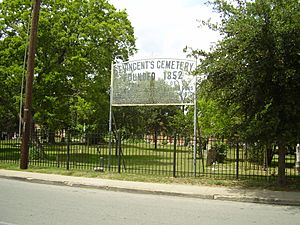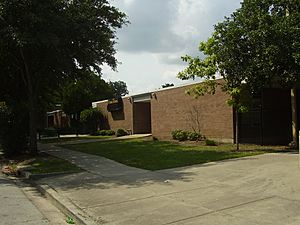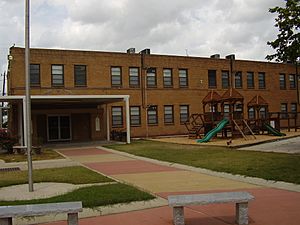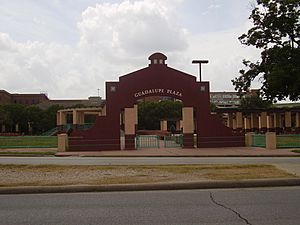Second Ward, Houston facts for kids
Second Ward is a historic area in Houston, Texas. People also call it Segundo Barrio, which means "second neighborhood" in Spanish. It was one of the first four main areas, or "wards," of Houston back in the 1800s.
Today, Second Ward is mostly bordered by Buffalo Bayou to the north. Lockwood Avenue is to the east, and railroad tracks are to the south and west. This area is part of Houston's East End community.
Second Ward used to have many German American residents. Now, it is mainly home to Mexican American families. Many Mexican-Americans moved here after World War II. The northern part of the area has many factories and large warehouses. Some old industrial buildings near Downtown have even become new homes.
Many buildings in Second Ward were built in the 1920s. They show the cool art deco style. In recent years, the area has gotten many upgrades. New street lights and better roads have been added. More people are also moving in, making the area grow and change. The Ripley House Community Center is a popular spot for people of all ages.
Contents
History of Second Ward
Second Ward was one of the first areas in Houston where many Mexican-American families lived. This happened in the early 1910s during the Mexican Revolution. At that time, the area had people from many backgrounds. These included Jewish, African American, and other groups.
When many Mexican Americans started moving to Houston, they first settled in Second Ward. It quickly became a center for their culture and social life. One of the first Mexican-American neighborhoods here was called El Alacrán. This name means "the scorpion." It used to be an area where German Americans lived.
By the 1920s, Mexican families became the main group in Second Ward. Other groups moved out. New places opened to help the community. These included a school for Mexican children and two churches. Our Lady of Guadalupe Catholic Church and the Mexican Methodist Episcopal Church were among them. After World War II, Mexican families started moving into nearby areas.
In the 1990s, there were plans to build homes on an old bus site. This site was called the Milby Bus Barn. Workers found old storage tanks there. Tests showed some chemicals like petroleum and lead in the soil. The city cleaned up the area. They removed a lot of soil and put in systems to clean the water. By 1999, the site was safe, but it stayed empty for a while.
Around 2006, many new homes were built in Second Ward. These included lofts and townhouses. This was a new type of housing for the area. People started to see Second Ward as a great place to live again.
In 2015, a group called the Carnalismo Brown Berets de Houston worked to protect the community. They wanted to make sure that new changes helped everyone in Second Ward.
Who Lives in Second Ward?
In 1860, about half of the people in Second Ward were born outside the United States. Many of these were people of German descent. Others came from places like Ireland, France, and Mexico.
By 1910, the area still had many people from different countries. There were German, Russian, Italian, and Mexican residents. This mix of cultures made Second Ward a very diverse place.
Schools in Second Ward
Students in Second Ward go to schools in the Houston Independent School District.
Rusk K-8 School is right in Second Ward. It teaches students from kindergarten to eighth grade. Other schools for this area include Jackson Middle School and Wheatley High School.
Some changes are happening with Rusk School's elementary grades. Over the next few years, younger students will go to Burnet Elementary School or Lantrip Elementary School.
There are also special high schools in the area. These include East Early College High School and Middle College High School-Felix Fraga. These schools help students earn college credits early.
The Our Lady of Guadalupe School is also in Second Ward. It is a Catholic school for students from kindergarten to eighth grade. It is part of the Our Lady of Guadalupe Church.
History of Schools
Anson Jones Elementary School used to be in Second Ward. It opened in 1892. Rusk Elementary School first opened in 1902. Our Lady of Guadalupe School started in 1912.
The first Rusk school building was taken down to build a highway. A new Rusk Elementary was built in 1960. It helped students from the Clayton Homes area.
Anson Jones Elementary School moved to a new spot in 1967. It closed in 2006 because fewer students were attending. The old school building is now used for other things.
Rusk School later added middle school grades. This helped students who were having trouble in bigger middle schools.
E. O. Smith Education Center closed in 2011. Students from Second Ward who were in grades 6-8 then started going to Jackson Middle School.
Colleges and Libraries
Students in Second Ward can go to the Houston Community College system.
The Houston Public Library Flores Neighborhood Library serves the Second Ward. This library had to close after Hurricane Harvey in 2017 due to water damage. It is expected to open again soon.
Getting Around Second Ward
The Metropolitan Transit Authority of Harris County (METRO) runs public transportation. This includes buses and the METRORail tram service. The tram station for this area is called Coffee Plant/Second Ward.
Fun Things to Do in Second Ward
Second Ward has many important cultural spots. These include Our Lady of Guadalupe Catholic Church, which is a well-known Mexican-American church. Talento Bilingüe de Houston is a theater that performs in two languages. Guadalupe Plaza is a public park where people can relax.
Our Lady of Guadalupe Church was the first Catholic church in Houston for Mexican families. People from all over Houston used to come here on Sundays. Second Ward was also home to Houston's very first Catholic church, St. Vincent's Church.
Guadalupe Plaza is about 1 mile (1.6 km) east of Downtown Houston. People have worked hard to improve this park. In 2009, there were plans for a big upgrade. The park's reconstruction started in 2014 and was finished in 2015.
The Navigation Esplanade is a walking park built in 2013. It is three blocks long and great for a stroll.
The Houston Saengerbund was a German-American singing group. It started in 1883. This group bought a house in 1913. It was the last German-American cultural group in Second Ward. The Houston Saengerbund left the area in 1935. In the late 1800s, Volksfest Park hosted a German-American festival called Volkfest. So many people went that a special tram line was added to the park in 1889.
Notable Residents
- Ninfa Laurenzo








